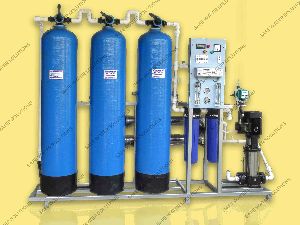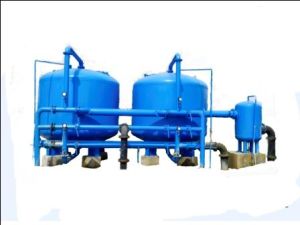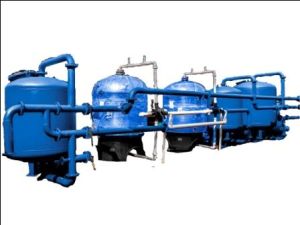
RO System

Reverse Osmosis Plant
Reverse Osmosis is a process in which dissolved inorganic solids (such as salts) are removed from a solution (such as water). This is accomplished by household water pressure pushing the tap water through a semipermeable membrane. Extra Features 250 LPH 500 LPH 1000 LPH 2000 LPH
...more
Iron Removal Plant
Iron can be a troublesome chemical in water supplies. Making up at least 5 percent of the earth’s crust, iron is one of the earth’s most plentiful resources. Rainwater as it infiltrates the soil and underlying geologic formations dissolves iron, causing it to seep into aquifers that serve as sources of groundwater for wells. Iron is mainly present in water in two forms: either the soluble ferrous iron or the insoluble ferric iron. Water containing ferrous iron is clear and colorless because the iron is completely dissolved. When exposed to air in the pressure tank or atmosphere, the water turns cloudy and a reddish brown substance begins to form. This sediment is the oxidized or ferric form of iron that will not dissolve in water.
...more
HEAVY METAL REMOVAL PLANT
Heavy metal pollution has become one of the most serious environmental problems today. The treatment of heavy metals is of special concern due to their recalcitrance and persistence in the environment. With the rapid development of industries such as metal plating facilities, mining operations, fertilizer industries, tanneries, batteries, paper industries and pesticides, etc., heavy metals wastewaters are directly or indirectly discharged into the environment increasingly, especially in developing countries. Unlike organic contaminants, heavy metals are not biodegradable and tend to accumulate in living organisms and many heavy metal ions are known to be toxic or carcinogenic. Toxic heavy metals of particular concern in treatment of industrial wastewaters include zinc, copper, nickel, mercury, cadmium, lead and chromium.
...more
Fluoride Removal Plant
Fluoride is a major, naturally occurring contaminant in drinking water in many regions of the world. At low levels, say 1mg/l, it is found to be beneficial in preventing dental caries. However, exposure to high levels can cause structural tooth damage and at a high enough level can cause skeletal damage, called Skeletal fluorosis. Skeletal fluorosis is a bone disease caused by excessive consumption of fluoride.Fluoride is a fairly common element that does not occur in the elemental state in nature because of its high reactivity. It accounts for about 0.3 g/kg of the earth's crust and exists in the form of fluorides in a number of minerals, of which fluorspar, cryolite, and fluorapatite are the most common.
...more
Arsenic Removal Plant
Arsenic is a natural element that can be found in rocks and soil, water, air, and in plants and animals. It can also be released into the environment from some agricultural and industrial sources. Arsenic is known to cause cancer, as well as many other serious health problems. Arsenic Removal Plant Arsenic is a natural element that can be found in rocks and soil, water, air, and in plants and animals. It can also be released into the environment from some agricultural and industrial sources. Arsenic is known to cause cancer, as well as many other serious health problems. Extra Features Capacity Capacity Capacity
...moreBe first to Rate
Rate ThisOpening Hours